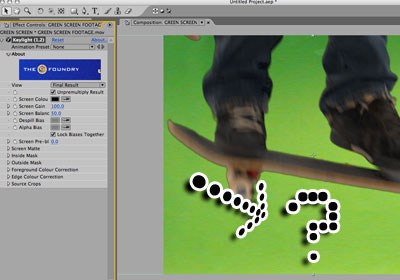

It introduced RAM cache that gave users real-time playback.

Nuke 7, delivered in 2012, had partial support for GPU acceleration. Node presets were aimed at making workflows in Nuke easier, and there were also updates to caching and OCIO nodes.

New SplineWarp and GridWarp nodes were included in Nuke, with Denoise and PlanarTracker nodes available in NukeX. Nuke 6.3 introduced Deep Compositing and the Particle System in NukeX.
#Foundry keylight plugin manual
Foundry’s Keylight keyer became a standard feature included with Nuke 6.0.įoundry also introduced NukeX 6.0 around this time, which had a bunch of extended tools such as an integrated 3D camera tracker, automated and manual lens distortion tools, FurnaceCore – Foundry’s re-engineered set of Furnace plug-ins – and a DepthGenerator plug-in. Nuke 6.0, released in 2010, incorporated a completely new shape rotoscope and paint toolset based on a rewritten core curve library and new RotoPaint node. Other features included per-node mask inputs and expanded LUT support for file I/O color-space conversion. The first major Foundry version of Nuke came in 2008 with 5.0, which saw the addition of Python for scripting, support for stereoscopic workflows, the ability to read, process and write more than 1000 channels per stream and support for EXR images. Back page from the D2 brochure.Ī major change took place when Foundry (then, The Foundry) productized Nuke in 2007. The front page of a D2 brochure from NAB in 2005.
#Foundry keylight plugin software
That same year, Digital Domain started D2 Software with the aim of developing and selling Nuke and other software it meant, of course, that Nuke became available to the public. In 2002, Nuke was recognized with an Academy Award for Scientific and Technical achievement (Academy Plaque) awarded to Bill Spitzak, Paul Van Camp, Jonathan Egstad, and Price Pethel.

Then, Nuke received an architectural re-design, which heralded the development of the famous 3D system inside the software. But it could do transforms and blur and sharpen filters and color corrections, and composites.”Ī GUI was introduced in version 2 of Nuke (which hit around 1994), which was built with an in-house GUI toolkit at Digital Domain called FLTK. In this Nukepedia interview, Spitzak mentions that version one of Nuke used “fixed-sized buffers and a command line. At first, it was a command line run tool. Nuke (meaning ‘New compositor’) began development in 1993 by Phil Beffrey and later Bill Spitzak at Digital Domain, where it was employed for internal use. Nuke at Digital Domain Nuke at Digital Domain Note: for good background information on Nuke, I would highly recommend Nukepedia and fxguide, which have provided extensive coverage of the software for many years. I would note there have been a number of crucial contributors to Nuke over the years and I have not tried to list these people since I would no doubt leave some of them out. Check out the timeline, below, where you can reminisce about all things that weren’t in the tool for a long time and now are, and discover when certain features were added. With Nuke 12.0 released last year and 12.1 just getting out there now, I asked Digital Domain and Foundry to help me look back at the history of Nuke in a visual way. Along the way, there have been several major developments with the tool, including deep compositing and, more recently, Smart Vectors. Nuke – the popular digital compositing tool – began life at VFX studio Digital Domain in 1993, before being productized by Foundry in 2007.


 0 kommentar(er)
0 kommentar(er)
